
Winfield Scott was an American military commander and political candidate. He served as a general in the United States Army from 1814 to 1861, taking part in the War of 1812, the Mexican–American War, the early stages of the American Civil War, and various conflicts with Native Americans. Scott was the Whig Party's presidential nominee in the 1852 presidential election, but was defeated by Democrat Franklin Pierce. He was known as "Old Fuss and Feathers" for his insistence on proper military etiquette, and as the "Grand Old Man of the Army" for his many years of service.

Winfield Scott Hancock was a career U.S. Army officer and the Democratic nominee for President of the United States in 1880. He served with distinction in the Army for four decades, including service in the Mexican–American War and as a Union general in the American Civil War. Known to his Army colleagues as "Hancock the Superb", he was noted in particular for his personal leadership at the Battle of Gettysburg in 1863. One military historian wrote, "No other Union general at Gettysburg dominated men by the sheer force of their presence more completely than Hancock." As another wrote, "his tactical skill had won him the quick admiration of adversaries who had come to know him as the 'Thunderbolt of the Army of the Potomac'." His military service continued after the Civil War, as Hancock participated in the military Reconstruction of the South and the Army's presence at the Western frontier.
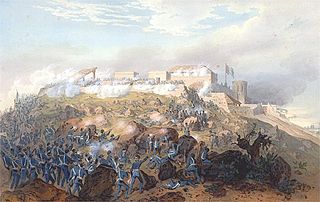
The Battle of Chapultepec in September 1847 was a battle between the United States Marine Corps and US Army against Mexican forces holding Chapultepec in Mexico City. The castle, sitting atop a 200-foot (60 m) tall hill, was an important position for the defense of the city. For the Battle for Mexico City of which the Battle of Chapultepec is a part, Gen Scott's US Army totaled 7,200 men, and Gen Santa Anna's Mexican Army totaled about 15,000. The Battle of Chapultepec saw about 2,000 US troops attack 880 Mexican troops and take Chapultepec in a 60–90 minute battle.

John Anthony Quitman was an American politician and soldier. He served as Governor of Mississippi from 1835 to 1836 as a Whig and again from 1850 to 1851 as a Democrat and one of the leading Fire-Eaters.
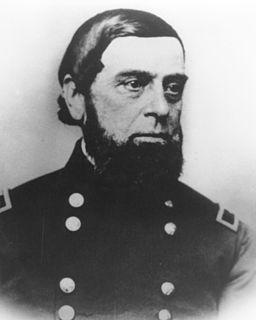
Jacob Zeilin was the United States Marine Corps' first non-brevet flag officer. He served as the seventh commandant of the United States Marine Corps, from 1864 to 1876.
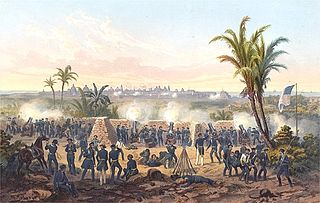
The Battle of Veracruz was a 20-day siege of the key Mexican beachhead seaport of Veracruz, during the Mexican–American War. Lasting from March 9–29, 1847, it began with the first large-scale amphibious assault conducted by United States military forces, and ended with the surrender and occupation of the city. U.S. forces then marched inland to Mexico City.

The Battle of Cerro Gordo, or Battle of Sierra Gordo, was an engagement in the Mexican–American War on April 18, 1847. The battle saw Winfield Scott's United States troops outflank Antonio López de Santa Anna's larger Mexican army, driving it from a strong defensive position.
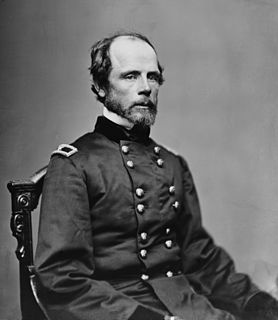
Darius Nash Couch was an American soldier, businessman, and naturalist. He served as a career U.S. Army officer during the Mexican–American War, the Second Seminole War, and as a general officer in the Union Army during the American Civil War.

Gordon Granger was a career U.S. Army officer and a Union general during the American Civil War. He distinguished himself at the Battle of Chickamauga.
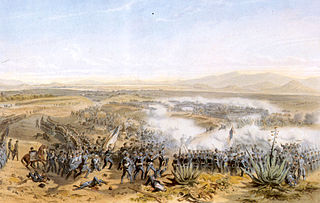
The Battle of Contreras, also known as the Battle of Padierna, took place on 19–20 August 1847, in the final encounters of the Mexican–American War. In the Battle of Churubusco, fighting continued the following day.
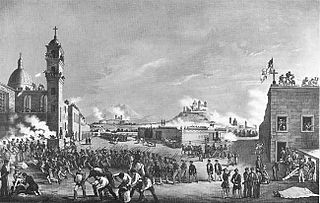
Following the Battle of Chapultepec, Santa Anna withdrew his forces from Mexico City, leading a portion in an attempt to take Puebla and cut off Scott's supply route from Veracruz. The Siege of Puebla began the same day Mexico City fell to Winfield Scott and lasted for 28 days before a relief force fought its way into the city.

William Jenkins Worth was a United States officer during the War of 1812, Second Seminole War, and Mexican–American War.

David Emanuel Twiggs, born in Georgia, was a career army officer, serving during the War of 1812, the Black Hawk War, and Mexican–American War.
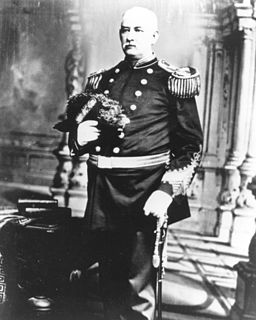
Charles Grymes McCawley was the eighth Commandant of the Marine Corps and served as an officer in the United States Marine Corps during the Mexican–American War and the American Civil War.
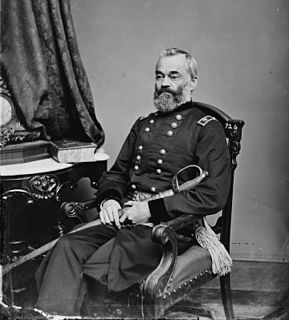
Samuel Peter Heintzelman was a United States Army general. He served in the Seminole War, the Mexican–American War, the Yuma War and the Cortina Troubles. During the American Civil War he was a prominent figure in the early months of the war rising to the command of a corps.

The Mexican–American War, also known in the United States as the Mexican War and in Mexico as the American intervention in Mexico, was an armed conflict between the United States of America and the United Mexican States (Mexico) from 1846 to 1848. It followed in the wake of the 1845 American annexation of the independent Republic of Texas. The unstable Mexican caudillo leadership of President/General Antonio López de Santa Anna still considered Texas to be its northeastern province and never recognized the Republic of Texas, which had seceded a decade earlier. In 1845, newly elected U.S. President James K. Polk sent troops to the disputed area and a diplomatic mission to Mexico. After Mexican forces attacked American forces, Polk cited this in his request that Congress declare war.

The Aztec Club of 1847 is a military society founded in 1847 by United States Army officers of the Mexican–American War. It exists as a hereditary organization including members who can trace a direct lineal connection to those originally eligible.

Events from the year 1847 in the United States.
Joaquín Rea Mexican general in the Mexican–American War.



















